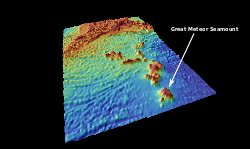Great Meteor Seamount
| Great Meteor Seamount | |
|---|---|
 Great Meteor Seamount at the southern edge of the Atlantis-Meteor Seamount Complex | |
| Summit depth | 270 m (890 ft) |
| Height | 4,500 m (14,800 ft) |
| Summit area | 50x28 km² (1465 km²)[1] |
| Location | |
| Location | North Atlantic Ocean, 1,000 km (620 mi) south of the Azores |
| Coordinates | 29°57′10.6″N 28°35′31.3″W / 29.952944°N 28.592028°WCoordinates: 29°57′10.6″N 28°35′31.3″W / 29.952944°N 28.592028°W |
| Geology | |
| Type | Guyot |
| Volcanic arc/chain | Seewarte Seamounts |
| History | |
| Discovery date | 1938 |
| Discovered by | Meteor |
The Great Meteor Seamount is the largest seamount in the North Atlantic (24 000 km3). This large guyot is one of the seamounts forming the Southern Azores Seamount Chain (SASC)[2], rooted on a large terrace located south of the Azores Archipelago in the Atlantic Ocean. The crust at the Great Meteor has an age of 85 Ma, deduced from the magnetic anomaly 34 (An34) at this location [3]. Its shallow and flat top, ranging between 150 and 300 m depth suggests, as for other SASC seamounts, that they may have been emerged sometime in the past [4]. The top of this seamount is covered by a thick layer (150 to 600 m) of limestone, pyroclastic rocks and bioclastic sandstones [5]. Dredged basalts from the top of the eastern and southeastern flanks of this seamount were dated by K-Ar yielding 10.7 ±0.5 and 16.3±0.4 Ma, respectively[6] . The oldest sample was recently dated by 40Ar/39Ar technique at 17 ± 0.3 Ma [7]. Two small seamounts exist located southwest of Great Meteor and encircled by the −3800 m bathymetric line. These are the Closs seamount, roughly oriented NNE-SSW, with its peak at 1400 m depth and covering an area of ~390 km2, and the Small Meteor, located NNE of Closs, with over 960 km2 and a flat top at −400 m.
The German research vessel Meteor discovered the tablemount between 1925 and 1927. It was given the name Great Meteor Bank, a designation still used in the official GEBCO gazetteer.
Formation
The New England hotspot formed the White Mountains 124 to 100 million years ago when the North American continent was directly overhead. As the continent drifted to the west, the hotspot gradually moved offshore. On a southeasterly course, the hotspot formed Bear Seamount, the oldest in the chain, about 100 to 103 million years ago. Over the course of millions of years, it continued creating the rest of the seamounts, eventually culminating in the Nashville Seamount about 83 million years ago. As the Atlantic Ocean continued to spread, the hotspot eventually traveled further east, forming the Great Meteor Seamount where it is found today.[8] Radiometric dating of basalt from the Great Meteor Seamount has given ages of about 11 and 16 million years old, with the bulk of the seamount possibly having formed about 22 million years ago.[9]
Ecology
The unique ecological condition of the Great Meteor Seamount is shown by the many endemic copepod and nematode species.[1]
References
- 1 2 SPOTLIGHT 5 Great Meteor Seamount
- ↑ Ribeiro, Luisa Pinto; Martins, Sofia; Hildenbrand, Anthony; Madureira, Pedro; Mata, João. "The genetic link between the Azores Archipelago and the Southern Azores Seamount Chain (SASC): The elemental, isotopic and chronological evidences". Lithos. 294-295: 133–146. Bibcode:2017Litho.294..133R. doi:10.1016/j.lithos.2017.08.019.
- ↑ Verhoef, Jaap (1984). "A Geophysical Study of the Atlantis-Meteor Seamount Complex". Geologica Ultraiectina. 38: 1–153. ISSN 0072-1026. Retrieved 14 April 2014.
- ↑ Gente, Pascal; Dyment, Jérôme; Maia, Marcia; Goslin, Jean (2003-10-01). "Interaction between the Mid-Atlantic Ridge and the Azores hot spot during the last 85 Myr: Emplacement and rifting of the hot spot-derived plateaus". Geochemistry, Geophysics, Geosystems. 4 (10): 8514. Bibcode:2003GGG.....4.8514G. doi:10.1029/2003gc000527. ISSN 1525-2027.
- ↑ Ulrich, von Rad, (1974-11-14). "Composition of bioclastic sands, carbonates and pyroclastic rocks of the Great Meteor and Josephine Seamounts, eastern North Atlantic". doi:10.1594/pangaea.548422.
- ↑ Wendt, I.; Kreuzer, H.; Müller, P.; Rad, U. von; Raschka, H. "K-Ar age of basalts from Great Meteor and Josephine seamounts (eastern North Atlantic)". Deep Sea Research and Oceanographic Abstracts. 23 (9): 849–862. Bibcode:1976DSROA..23..849W. doi:10.1016/0011-7471(76)90852-4.
- ↑ Geldmacher, Jörg; Hoernle, Kaj; Klügel, Andreas; Bogaard, Paul v. d.; Wombacher, Frank; Berning, Björn (2006-09-01). "Origin and geochemical evolution of the Madeira-Tore Rise (eastern North Atlantic)". Journal of Geophysical Research: Solid Earth. 111 (B9): B09206. Bibcode:2006JGRB..111.9206G. doi:10.1029/2005jb003931. ISSN 2156-2202.
- ↑ "Geological Origin of the New England Seamount Chain". Office of Ocean Exploration and Research, National Oceanic and Atmospheric Administration. U.S. Department of Commerce. 2005. Retrieved 14 April 2014. Revised August 25, 2010 by the Ocean Explorer
- ↑ Hekinian, Roger; Stoffers, Peter; Cheminée, Jean-Louis (2012). Oceanic Hotspots: Intraplate Submarine Magmatism and Tectonism. Springer. p. 116. ISBN 978-3-642-62290-8.